Abstract
1 Slow-reacting substance of anaphylaxis (SRS-A) was released in the peritoneum of passively sensitized rats challenged with ovalbumin and from rat isolated peritoneal cells stimulated with calcium ionophore A23187. 2 Both monocytes (macrophages) and mast cells appear to be involved in the synthesis and release of SRS-A. 3 The immunological release of SRS-A in vivo is enhanced by indomethacin and inhibited by dexamethasone, mepacrine, 1-phenyl-3-pyrazolidone (1-P-3-P), and methylimidazole. 4 SRS-A release induced by A23187 in vitro is inhibited by dexamethasone, indomethacin 1-P-3-P, eicosatetraynoic acid (ETA) and 15-hydroperoxy arachidonic acid. The inhibition induced by dexamethasone, indomethacin and 1-P-3-P is reduced by an increase in the calcium concentration from 1 mM to 5 mM, whereas the inhibition induced by ETA is increased. 5 The results suggest that a lipoxygenase is important in the synthesis and release by SRS-A.
Full text
PDF
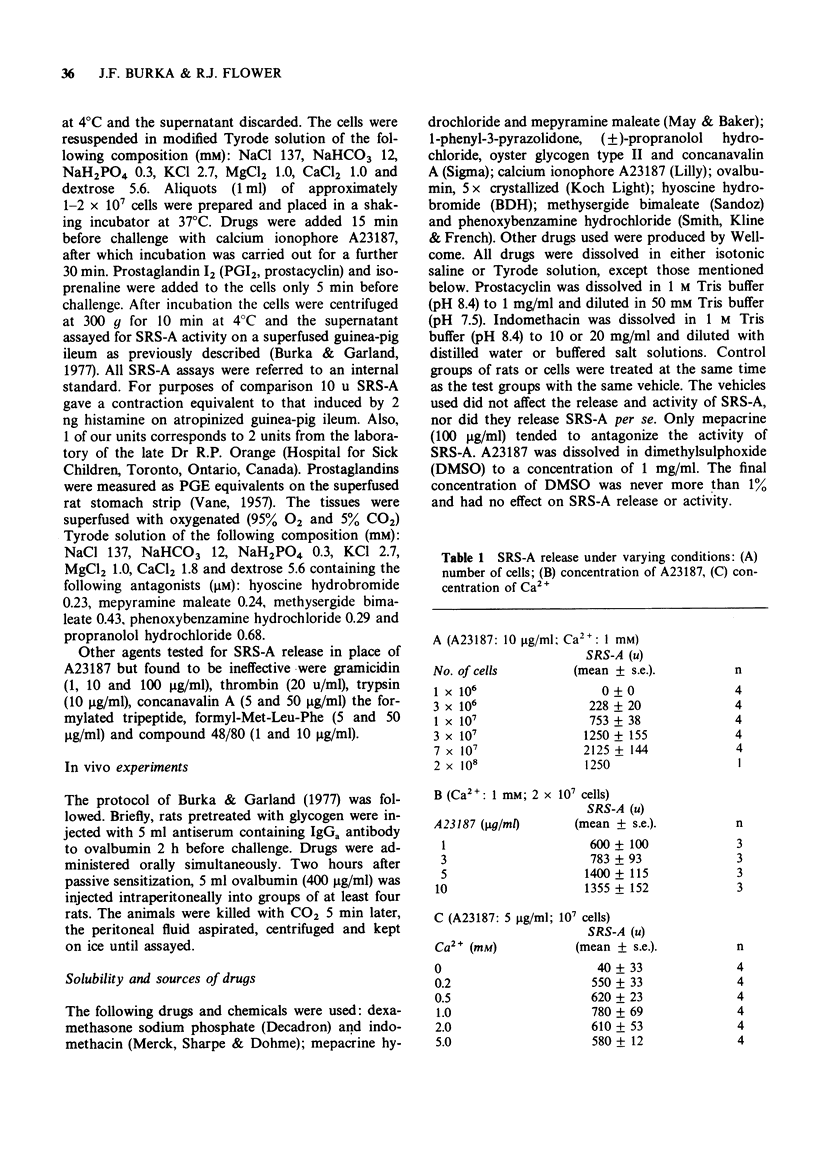
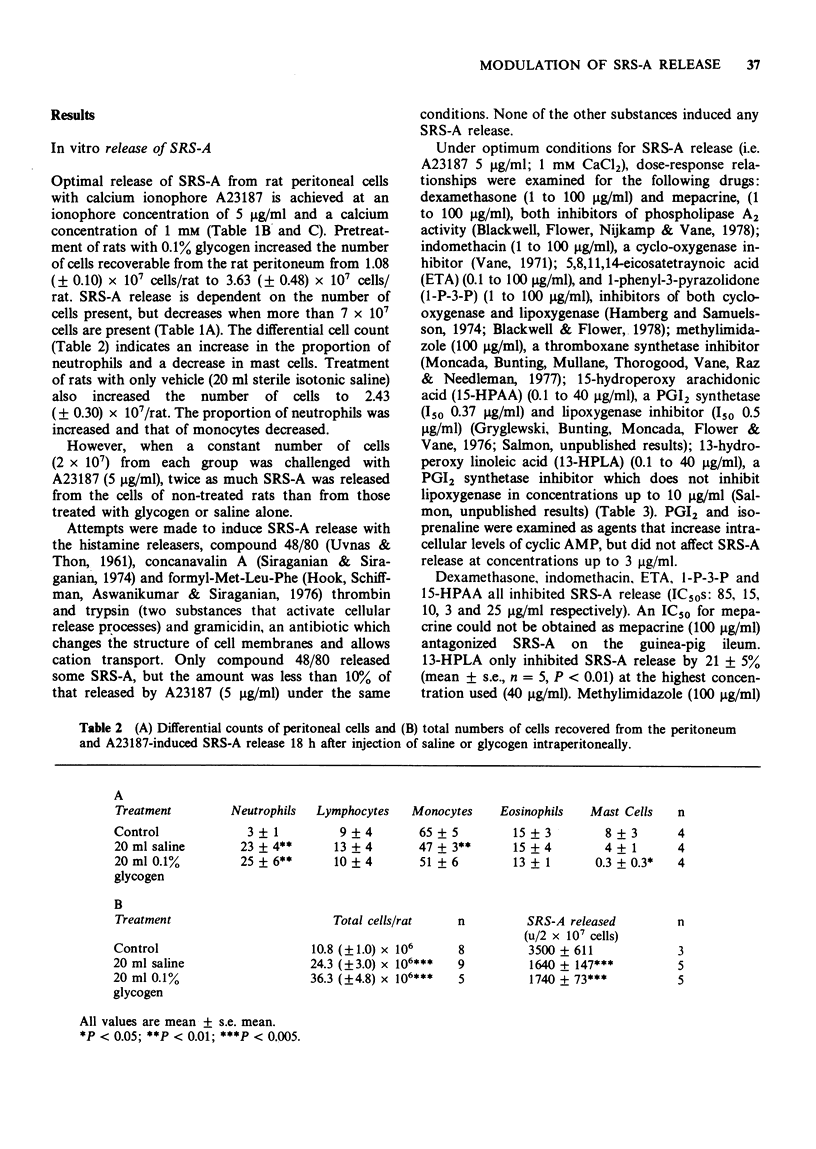
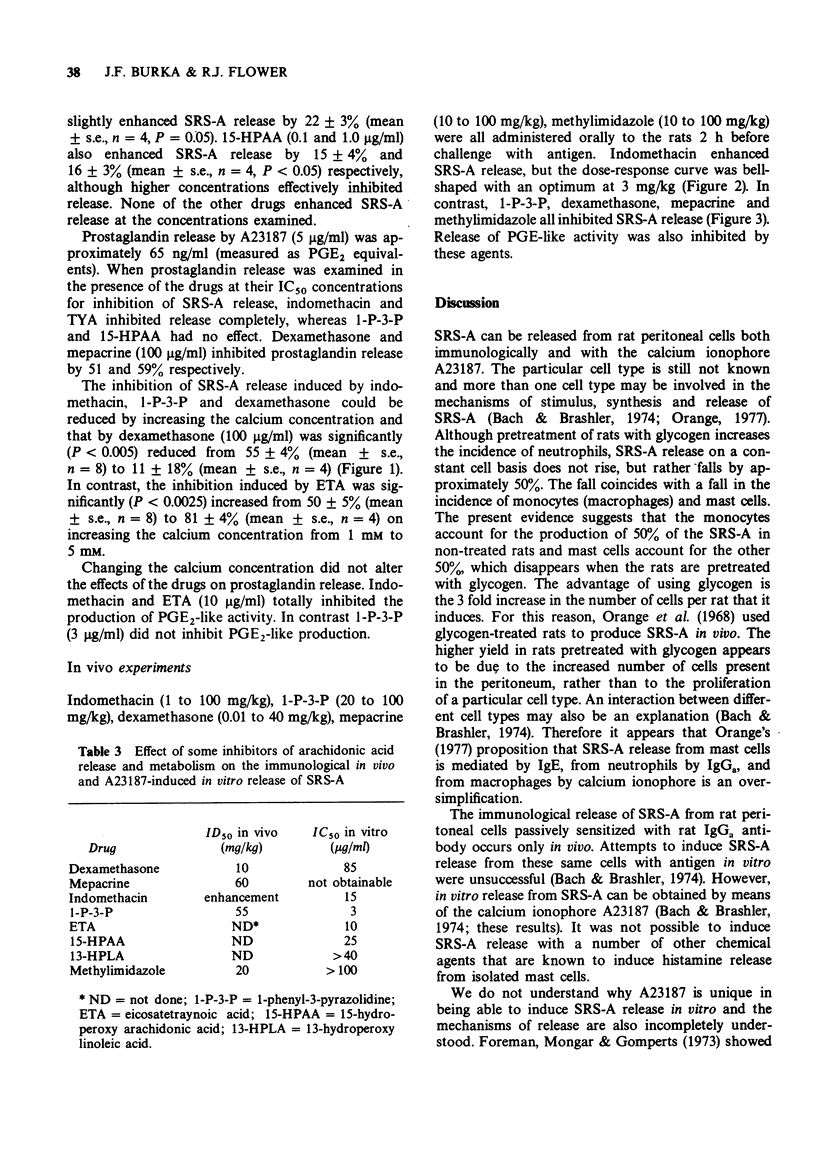
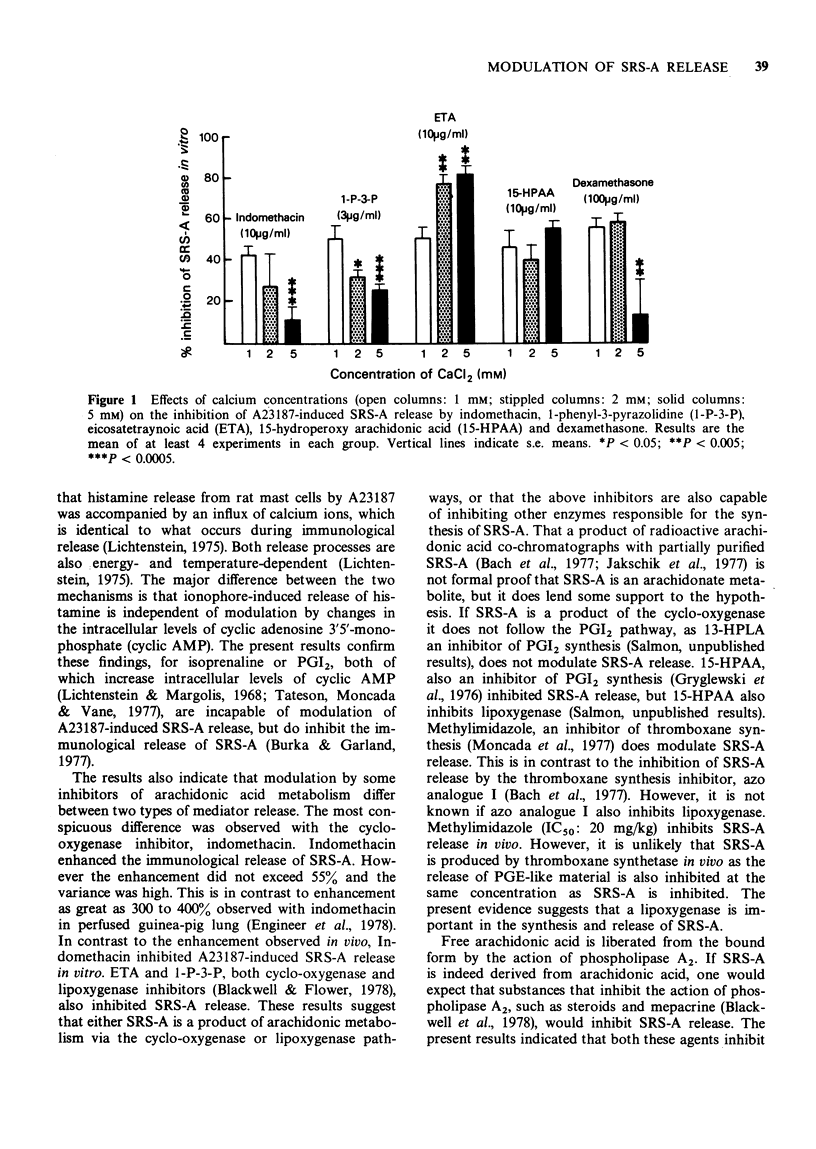
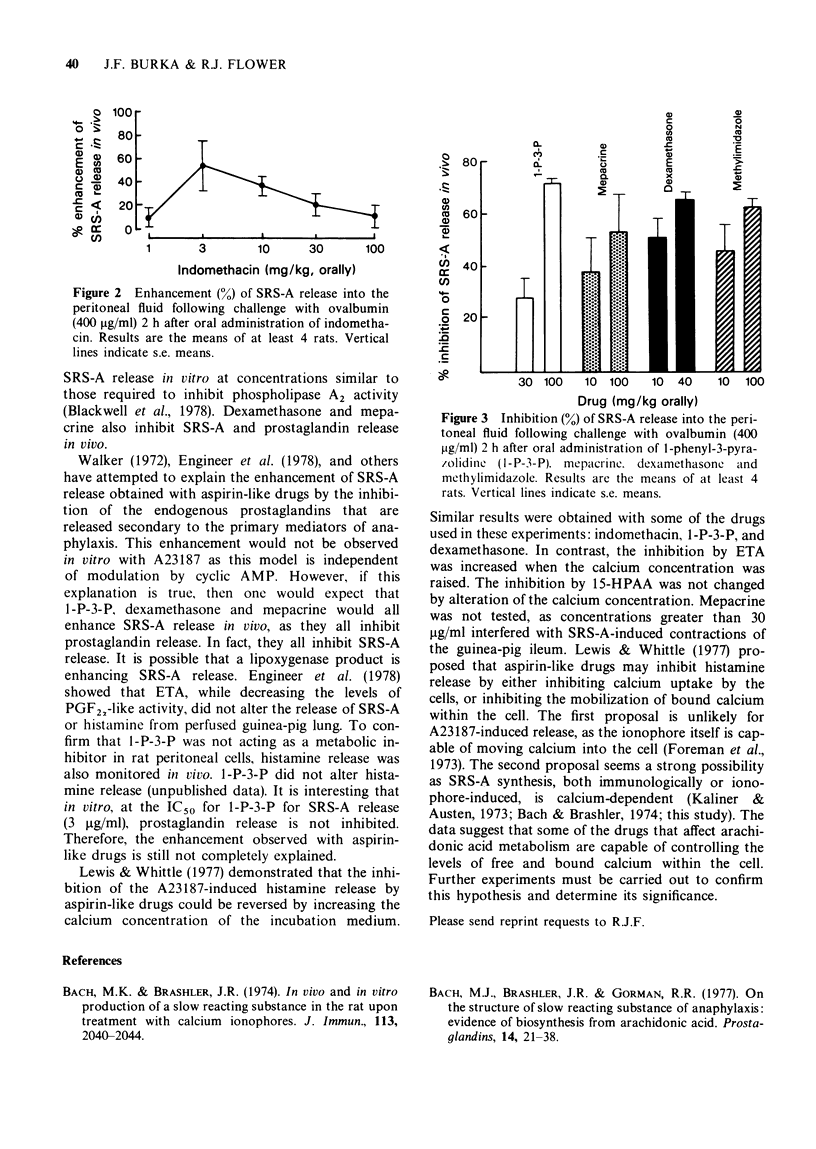
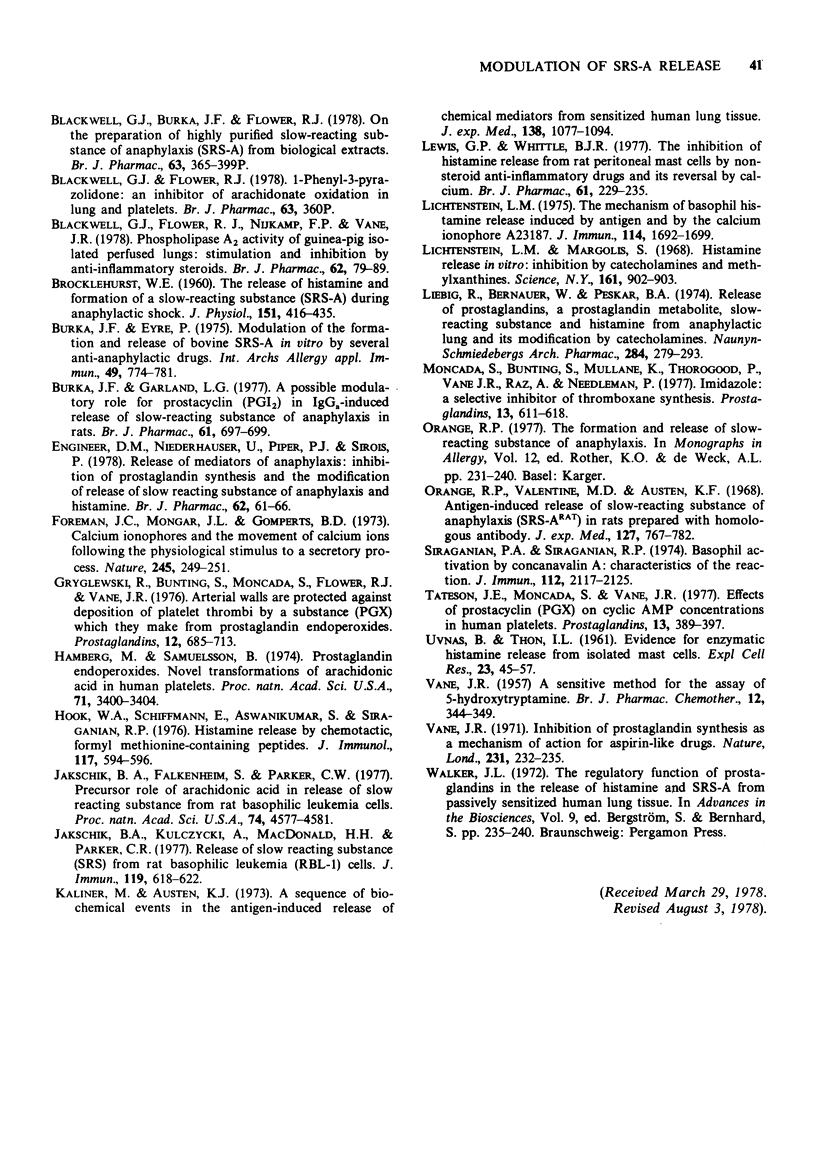
Selected References
These references are in PubMed. This may not be the complete list of references from this article.
- BROCKLEHURST W. E. The release of histamine and formation of a slow-reacting substance (SRS-A) during anaphylactic shock. J Physiol. 1960 Jun;151:416–435. doi: 10.1113/jphysiol.1960.sp006449. [DOI] [PMC free article] [PubMed] [Google Scholar]
- Bach M. K., Brashler J. R., Gorman R. R. On the structure of slow reacting substance of anaphylaxis: evidence of biosynthesis from arachidonic acid. Prostaglandins. 1977 Jul;14(1):21–38. doi: 10.1016/0090-6980(77)90154-x. [DOI] [PubMed] [Google Scholar]
- Bach M. K., Brashler J. R. In vivo and in vitro production of a slow reacting substance in the rat upon treatment with calcium ionophores. J Immunol. 1974 Dec;113(6):2040–2044. [PubMed] [Google Scholar]
- Blackwell G. J., Flower R. J. 1-Phenyl-3-pyrazolidone: an inhibitor of arachidonate oxidation in lung and platelets [proceedings]. Br J Pharmacol. 1978 Jun;63(2):360P–360P. [PMC free article] [PubMed] [Google Scholar]
- Blackwell G. J., Flower R. J., Nijkamp F. P., Vane J. R. Phospholipase A2 activity of guinea-pig isolated perfused lungs: stimulation, and inhibition by anti-inflammatory steroids. Br J Pharmacol. 1978 Jan;62(1):79–89. doi: 10.1111/j.1476-5381.1978.tb07009.x. [DOI] [PMC free article] [PubMed] [Google Scholar]
- Burka J. F., Eyre P. Modulation of the formation and release of bovine SRS-A in vitro by several anti-anaphylactic drugs. Int Arch Allergy Appl Immunol. 1975;49(6):774–781. doi: 10.1159/000231461. [DOI] [PubMed] [Google Scholar]
- Burka J. F., Garland L. G. A possible modulatory role for prostacyclin (PGI2) INIgGa-induced release of slow-reacting substance of anaphylaxis in rats. Br J Pharmacol. 1977 Dec;61(4):697–699. doi: 10.1111/j.1476-5381.1977.tb07564.x. [DOI] [PMC free article] [PubMed] [Google Scholar]
- Engineer D. M., Niederhauser U., Piper P. J., Sirois P. Release of mediators of anaphylaxis: inhibition of prostaglandin synthesis and the modification of release of slow reacting substance of anaphylaxis and histamine. Br J Pharmacol. 1978 Jan;62(1):61–66. doi: 10.1111/j.1476-5381.1978.tb07006.x. [DOI] [PMC free article] [PubMed] [Google Scholar]
- Foreman J. C., Mongar J. L., Gomperts B. D. Calcium ionophores and movement of calcium ions following the physiological stimulus to a secretory process. Nature. 1973 Oct 5;245(5423):249–251. doi: 10.1038/245249a0. [DOI] [PubMed] [Google Scholar]
- Gryglewski R. J., Bunting S., Moncada S., Flower R. J., Vane J. R. Arterial walls are protected against deposition of platelet thrombi by a substance (prostaglandin X) which they make from prostaglandin endoperoxides. Prostaglandins. 1976 Nov;12(5):685–713. doi: 10.1016/0090-6980(76)90047-2. [DOI] [PubMed] [Google Scholar]
- Hamberg M., Samuelsson B. Prostaglandin endoperoxides. Novel transformations of arachidonic acid in human platelets. Proc Natl Acad Sci U S A. 1974 Sep;71(9):3400–3404. doi: 10.1073/pnas.71.9.3400. [DOI] [PMC free article] [PubMed] [Google Scholar]
- Hook W. A., Schiffmann E., Aswanikumar S., Siraganian R. P. Histamine release by chemotactic, formyl methionine-containing peptides. J Immunol. 1976 Aug;117(2):594–596. [PubMed] [Google Scholar]
- Jakschik B. A., Falkenhein S., Parker C. W. Precursor role of arachidonic acid in release of slow reacting substance from rat basophilic leukemia cells. Proc Natl Acad Sci U S A. 1977 Oct;74(10):4577–4581. doi: 10.1073/pnas.74.10.4577. [DOI] [PMC free article] [PubMed] [Google Scholar]
- Jakschik B. A., Kulczycki A., Jr, MacDonald H. H., Parker C. W. Release of slow reacting substance (SRS) from rat basophilic leukemia (RBL-1) cells. J Immunol. 1977 Aug;119(2):618–622. [PubMed] [Google Scholar]
- Kaliner M., Austen K. F. A sequence of biochemical events in the antigen-induced release of chemical mediators from sensitized human lung tissue. J Exp Med. 1973 Nov 1;138(5):1077–1094. doi: 10.1084/jem.138.5.1077. [DOI] [PMC free article] [PubMed] [Google Scholar]
- Lewis G. P., Whittle B. J. The inhibition of histamine release from rat peritoneal mast cells by non-steroid anti-inflammatory drugs and its reversal by calcium. Br J Pharmacol. 1977 Oct;61(2):229–235. doi: 10.1111/j.1476-5381.1977.tb08409.x. [DOI] [PMC free article] [PubMed] [Google Scholar]
- Lichtenstein L. M., Margolis S. Histamine release in vitro: inhibition by catecholamines and methylxanthines. Science. 1968 Aug 30;161(3844):902–903. doi: 10.1126/science.161.3844.902. [DOI] [PubMed] [Google Scholar]
- Lichtenstein L. M. The mechanism of basophil histamine release induced by antigen and by the calcium ionophore A23187. J Immunol. 1975 Jun;114(6):1692–1699. [PubMed] [Google Scholar]
- Liebig R., Bernauer W., Peskar B. A. Release of prostaglandins, a prostaglandin metabolite, slow-reacting substance and histamine from anaphylactic lungs, and its modification by catecholamines. Naunyn Schmiedebergs Arch Pharmacol. 1974;284(3):279–293. doi: 10.1007/BF00500347. [DOI] [PubMed] [Google Scholar]
- Moncada S., Bunting S., Mullane K., Thorogood P., Vane J. R., Raz A., Needleman P. Imidazole: a selective inhibitor of thromboxane synthetase. Prostaglandins. 1977 Apr;13(4):611–618. doi: 10.1016/0090-6980(77)90232-5. [DOI] [PubMed] [Google Scholar]
- Orange R. P. The formation and release of slow-reacting substance of anaphylaxis. Monogr Allergy. 1977;12:231–240. [PubMed] [Google Scholar]
- Orange R. P., Valentine M. D., Austen K. F. Antigen-induced release of slow reacting substance of anaphylaxis (SRS-A rat) in rats prepared with homologous antibody. J Exp Med. 1968 Apr 1;127(4):767–782. doi: 10.1084/jem.127.4.767. [DOI] [PMC free article] [PubMed] [Google Scholar]
- Siraganian P. A., Siraganian R. P. Basophil activation by concanavalin A: characteristics of the reaction. J Immunol. 1974 Jun;112(6):2117–2125. [PubMed] [Google Scholar]
- Tateson J. E., Moncada S., Vane J. R. Effects of prostacyclin (PGX) on cyclic AMP concentrations in human platelets. Prostaglandins. 1977 Mar;13(3):389–397. doi: 10.1016/0090-6980(77)90019-3. [DOI] [PubMed] [Google Scholar]
- UVNAS B., THON I. L. Evidence for enzymatic histamine release from isolated rat mast cells. Exp Cell Res. 1961 Feb;23:45–57. doi: 10.1016/0014-4827(61)90062-3. [DOI] [PubMed] [Google Scholar]
- VANE J. R. A sensitive method for the assay of 5-hydroxytryptamine. Br J Pharmacol Chemother. 1957 Sep;12(3):344–349. doi: 10.1111/j.1476-5381.1957.tb00146.x. [DOI] [PMC free article] [PubMed] [Google Scholar]
- Vane J. R. Inhibition of prostaglandin synthesis as a mechanism of action for aspirin-like drugs. Nat New Biol. 1971 Jun 23;231(25):232–235. doi: 10.1038/newbio231232a0. [DOI] [PubMed] [Google Scholar]


